Strategically relevant factors in GoPro’s macro-environment
VerifiedAdded on 2023/04/08
|14
|2404
|356
AI Summary
This article discusses the strategically relevant factors in GoPro’s macro-environment and provides a PESTEL analysis of the action camera industry and opportunities available for GoPro.
Contribute Materials
Your contribution can guide someone’s learning journey. Share your
documents today.
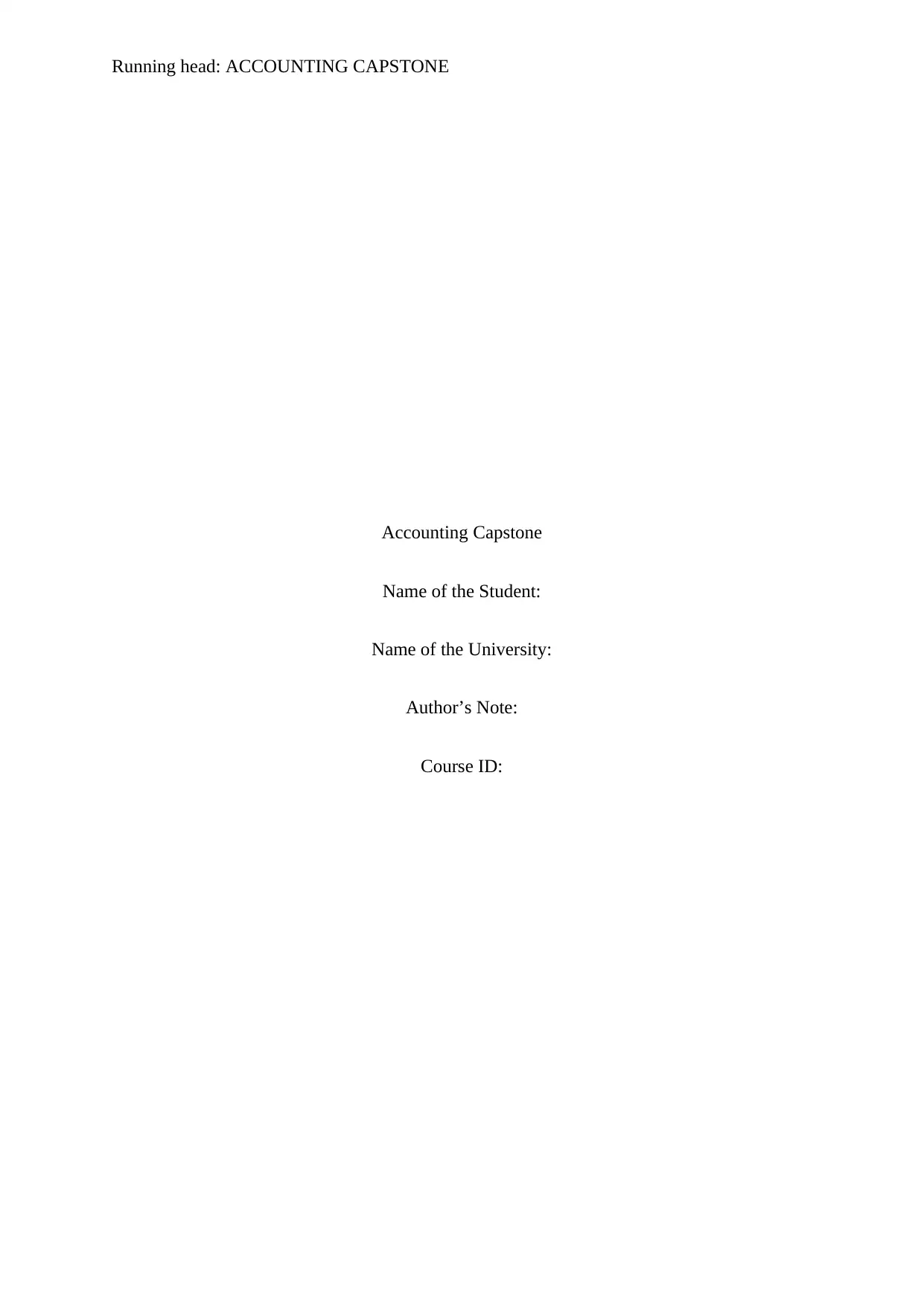
Running head: ACCOUNTING CAPSTONE
Accounting Capstone
Name of the Student:
Name of the University:
Author’s Note:
Course ID:
Accounting Capstone
Name of the Student:
Name of the University:
Author’s Note:
Course ID:
Secure Best Marks with AI Grader
Need help grading? Try our AI Grader for instant feedback on your assignments.

1ACCOUNTING CAPSTONE
Table of Contents
Answer to Question 1:................................................................................................................2
Strategically relevant factors in GoPro’s macro-environment:..............................................2
PESTEL analysis of the action camera industry and opportunities available for GoPro:.....2
Answer to Question 2:................................................................................................................4
Business model and competitive strategy of GoPro:.............................................................4
Effectiveness of the adopted approach to sustainable competitive advantage:......................5
Answer to Question 3:................................................................................................................5
Key resources:........................................................................................................................5
Competitive capabilities:........................................................................................................7
Answer to Question 4:................................................................................................................8
Answer to Question 5:................................................................................................................9
Answer to Question 6:..............................................................................................................10
References:...............................................................................................................................11
Appendix:.................................................................................................................................13
Table of Contents
Answer to Question 1:................................................................................................................2
Strategically relevant factors in GoPro’s macro-environment:..............................................2
PESTEL analysis of the action camera industry and opportunities available for GoPro:.....2
Answer to Question 2:................................................................................................................4
Business model and competitive strategy of GoPro:.............................................................4
Effectiveness of the adopted approach to sustainable competitive advantage:......................5
Answer to Question 3:................................................................................................................5
Key resources:........................................................................................................................5
Competitive capabilities:........................................................................................................7
Answer to Question 4:................................................................................................................8
Answer to Question 5:................................................................................................................9
Answer to Question 6:..............................................................................................................10
References:...............................................................................................................................11
Appendix:.................................................................................................................................13
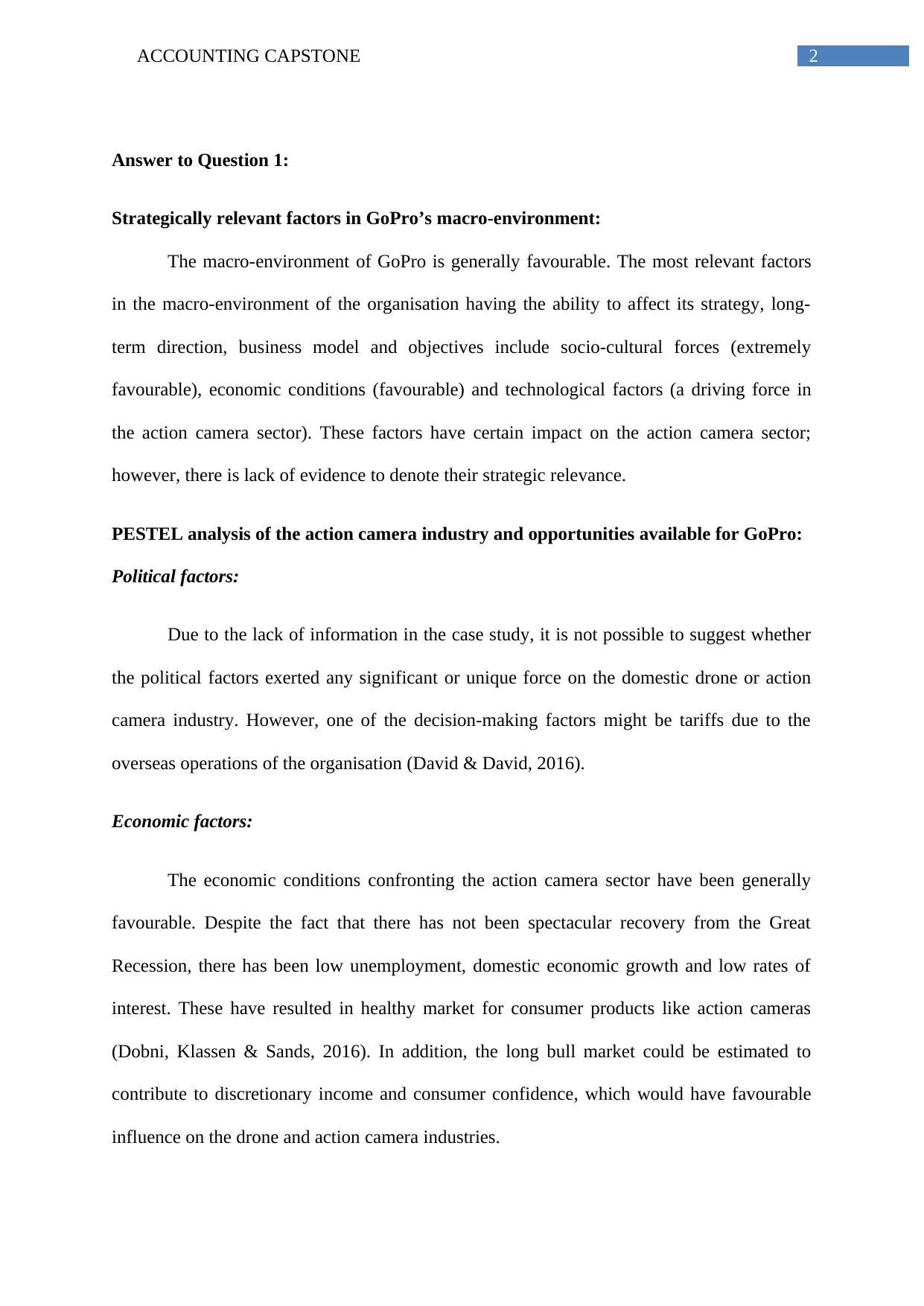
2ACCOUNTING CAPSTONE
Answer to Question 1:
Strategically relevant factors in GoPro’s macro-environment:
The macro-environment of GoPro is generally favourable. The most relevant factors
in the macro-environment of the organisation having the ability to affect its strategy, long-
term direction, business model and objectives include socio-cultural forces (extremely
favourable), economic conditions (favourable) and technological factors (a driving force in
the action camera sector). These factors have certain impact on the action camera sector;
however, there is lack of evidence to denote their strategic relevance.
PESTEL analysis of the action camera industry and opportunities available for GoPro:
Political factors:
Due to the lack of information in the case study, it is not possible to suggest whether
the political factors exerted any significant or unique force on the domestic drone or action
camera industry. However, one of the decision-making factors might be tariffs due to the
overseas operations of the organisation (David & David, 2016).
Economic factors:
The economic conditions confronting the action camera sector have been generally
favourable. Despite the fact that there has not been spectacular recovery from the Great
Recession, there has been low unemployment, domestic economic growth and low rates of
interest. These have resulted in healthy market for consumer products like action cameras
(Dobni, Klassen & Sands, 2016). In addition, the long bull market could be estimated to
contribute to discretionary income and consumer confidence, which would have favourable
influence on the drone and action camera industries.
Answer to Question 1:
Strategically relevant factors in GoPro’s macro-environment:
The macro-environment of GoPro is generally favourable. The most relevant factors
in the macro-environment of the organisation having the ability to affect its strategy, long-
term direction, business model and objectives include socio-cultural forces (extremely
favourable), economic conditions (favourable) and technological factors (a driving force in
the action camera sector). These factors have certain impact on the action camera sector;
however, there is lack of evidence to denote their strategic relevance.
PESTEL analysis of the action camera industry and opportunities available for GoPro:
Political factors:
Due to the lack of information in the case study, it is not possible to suggest whether
the political factors exerted any significant or unique force on the domestic drone or action
camera industry. However, one of the decision-making factors might be tariffs due to the
overseas operations of the organisation (David & David, 2016).
Economic factors:
The economic conditions confronting the action camera sector have been generally
favourable. Despite the fact that there has not been spectacular recovery from the Great
Recession, there has been low unemployment, domestic economic growth and low rates of
interest. These have resulted in healthy market for consumer products like action cameras
(Dobni, Klassen & Sands, 2016). In addition, the long bull market could be estimated to
contribute to discretionary income and consumer confidence, which would have favourable
influence on the drone and action camera industries.
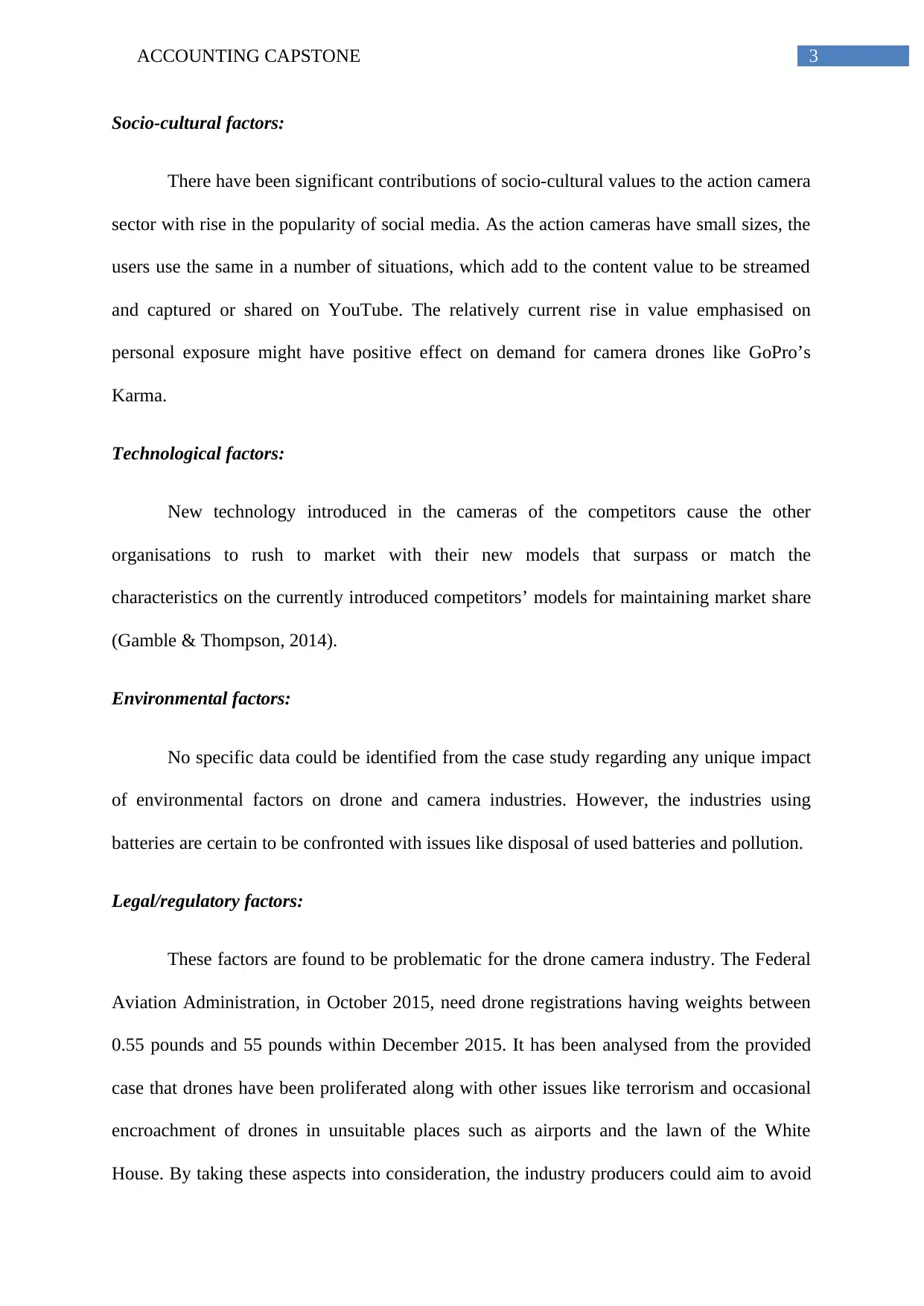
3ACCOUNTING CAPSTONE
Socio-cultural factors:
There have been significant contributions of socio-cultural values to the action camera
sector with rise in the popularity of social media. As the action cameras have small sizes, the
users use the same in a number of situations, which add to the content value to be streamed
and captured or shared on YouTube. The relatively current rise in value emphasised on
personal exposure might have positive effect on demand for camera drones like GoPro’s
Karma.
Technological factors:
New technology introduced in the cameras of the competitors cause the other
organisations to rush to market with their new models that surpass or match the
characteristics on the currently introduced competitors’ models for maintaining market share
(Gamble & Thompson, 2014).
Environmental factors:
No specific data could be identified from the case study regarding any unique impact
of environmental factors on drone and camera industries. However, the industries using
batteries are certain to be confronted with issues like disposal of used batteries and pollution.
Legal/regulatory factors:
These factors are found to be problematic for the drone camera industry. The Federal
Aviation Administration, in October 2015, need drone registrations having weights between
0.55 pounds and 55 pounds within December 2015. It has been analysed from the provided
case that drones have been proliferated along with other issues like terrorism and occasional
encroachment of drones in unsuitable places such as airports and the lawn of the White
House. By taking these aspects into consideration, the industry producers could aim to avoid
Socio-cultural factors:
There have been significant contributions of socio-cultural values to the action camera
sector with rise in the popularity of social media. As the action cameras have small sizes, the
users use the same in a number of situations, which add to the content value to be streamed
and captured or shared on YouTube. The relatively current rise in value emphasised on
personal exposure might have positive effect on demand for camera drones like GoPro’s
Karma.
Technological factors:
New technology introduced in the cameras of the competitors cause the other
organisations to rush to market with their new models that surpass or match the
characteristics on the currently introduced competitors’ models for maintaining market share
(Gamble & Thompson, 2014).
Environmental factors:
No specific data could be identified from the case study regarding any unique impact
of environmental factors on drone and camera industries. However, the industries using
batteries are certain to be confronted with issues like disposal of used batteries and pollution.
Legal/regulatory factors:
These factors are found to be problematic for the drone camera industry. The Federal
Aviation Administration, in October 2015, need drone registrations having weights between
0.55 pounds and 55 pounds within December 2015. It has been analysed from the provided
case that drones have been proliferated along with other issues like terrorism and occasional
encroachment of drones in unsuitable places such as airports and the lawn of the White
House. By taking these aspects into consideration, the industry producers could aim to avoid
Secure Best Marks with AI Grader
Need help grading? Try our AI Grader for instant feedback on your assignments.

4ACCOUNTING CAPSTONE
products, which are subject to regulation and instead, they would produce models not needing
any registration (Hill, Jones & Schilling, 2014).
Answer to Question 2:
Business model and competitive strategy of GoPro:
The business strategy of GoPro has been to develop product solutions for assisting the
customers in managing, sharing, capturing and enjoying some significant moments in their
lives. Moreover, the organisation has formulated GoPro Entertainment and it planned to
expand into different related businesses like drones and software (Gopro.com, 2019). It
concentrated on innovation and product leadership in their cameras as well as in batteries,
accessories and mounts. The organisation has raised its focus on solutions formed so that
organising, editing, content sharing and planned release of a platform related to content
management for 2016 could be simplified. For example, the GoPro for desktop has been
released that would facilitate accessing, offloading, editing and accessing content. It has been
looking ahead with new products to 2016 including its next generation capture device, the
GoPro drone “Karma”, the Hero5 along with devices for enabling virtual reality content
captures.
The strategy of GoPro has been developing and changing. The initial strategy was to
form and sell action cameras that turned out to be successful in the initial years of the action
camera sector. However, with the passage of time, it has evolved into diversified lifestyle
organisation. In 2015, the organisation has shifted its focus for forming product solutions
enabling customers to share, capture, manage and enjoy some of their crucial moments.
Moreover, it has diversified its business operations to drones and software.
products, which are subject to regulation and instead, they would produce models not needing
any registration (Hill, Jones & Schilling, 2014).
Answer to Question 2:
Business model and competitive strategy of GoPro:
The business strategy of GoPro has been to develop product solutions for assisting the
customers in managing, sharing, capturing and enjoying some significant moments in their
lives. Moreover, the organisation has formulated GoPro Entertainment and it planned to
expand into different related businesses like drones and software (Gopro.com, 2019). It
concentrated on innovation and product leadership in their cameras as well as in batteries,
accessories and mounts. The organisation has raised its focus on solutions formed so that
organising, editing, content sharing and planned release of a platform related to content
management for 2016 could be simplified. For example, the GoPro for desktop has been
released that would facilitate accessing, offloading, editing and accessing content. It has been
looking ahead with new products to 2016 including its next generation capture device, the
GoPro drone “Karma”, the Hero5 along with devices for enabling virtual reality content
captures.
The strategy of GoPro has been developing and changing. The initial strategy was to
form and sell action cameras that turned out to be successful in the initial years of the action
camera sector. However, with the passage of time, it has evolved into diversified lifestyle
organisation. In 2015, the organisation has shifted its focus for forming product solutions
enabling customers to share, capture, manage and enjoy some of their crucial moments.
Moreover, it has diversified its business operations to drones and software.
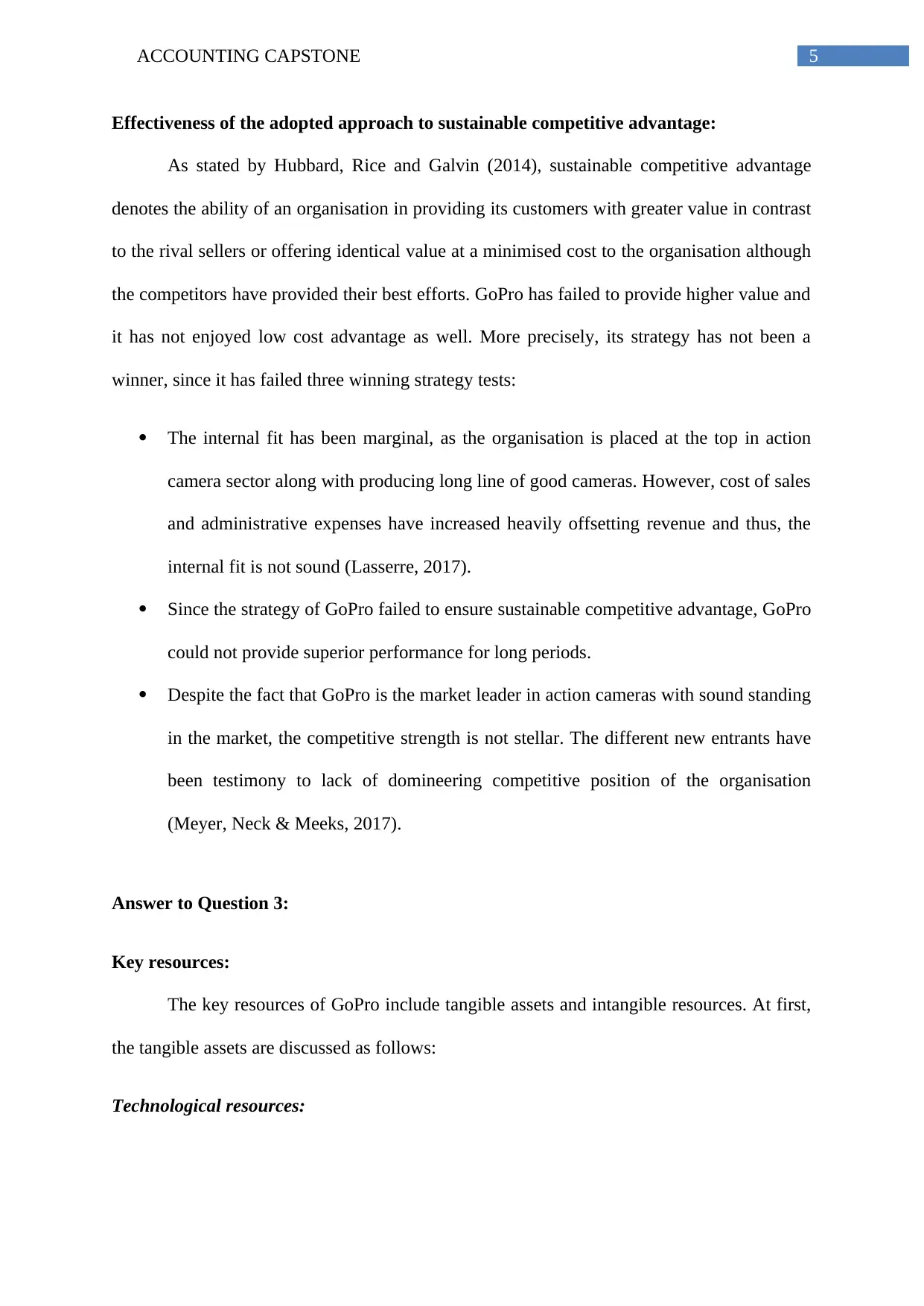
5ACCOUNTING CAPSTONE
Effectiveness of the adopted approach to sustainable competitive advantage:
As stated by Hubbard, Rice and Galvin (2014), sustainable competitive advantage
denotes the ability of an organisation in providing its customers with greater value in contrast
to the rival sellers or offering identical value at a minimised cost to the organisation although
the competitors have provided their best efforts. GoPro has failed to provide higher value and
it has not enjoyed low cost advantage as well. More precisely, its strategy has not been a
winner, since it has failed three winning strategy tests:
The internal fit has been marginal, as the organisation is placed at the top in action
camera sector along with producing long line of good cameras. However, cost of sales
and administrative expenses have increased heavily offsetting revenue and thus, the
internal fit is not sound (Lasserre, 2017).
Since the strategy of GoPro failed to ensure sustainable competitive advantage, GoPro
could not provide superior performance for long periods.
Despite the fact that GoPro is the market leader in action cameras with sound standing
in the market, the competitive strength is not stellar. The different new entrants have
been testimony to lack of domineering competitive position of the organisation
(Meyer, Neck & Meeks, 2017).
Answer to Question 3:
Key resources:
The key resources of GoPro include tangible assets and intangible resources. At first,
the tangible assets are discussed as follows:
Technological resources:
Effectiveness of the adopted approach to sustainable competitive advantage:
As stated by Hubbard, Rice and Galvin (2014), sustainable competitive advantage
denotes the ability of an organisation in providing its customers with greater value in contrast
to the rival sellers or offering identical value at a minimised cost to the organisation although
the competitors have provided their best efforts. GoPro has failed to provide higher value and
it has not enjoyed low cost advantage as well. More precisely, its strategy has not been a
winner, since it has failed three winning strategy tests:
The internal fit has been marginal, as the organisation is placed at the top in action
camera sector along with producing long line of good cameras. However, cost of sales
and administrative expenses have increased heavily offsetting revenue and thus, the
internal fit is not sound (Lasserre, 2017).
Since the strategy of GoPro failed to ensure sustainable competitive advantage, GoPro
could not provide superior performance for long periods.
Despite the fact that GoPro is the market leader in action cameras with sound standing
in the market, the competitive strength is not stellar. The different new entrants have
been testimony to lack of domineering competitive position of the organisation
(Meyer, Neck & Meeks, 2017).
Answer to Question 3:
Key resources:
The key resources of GoPro include tangible assets and intangible resources. At first,
the tangible assets are discussed as follows:
Technological resources:
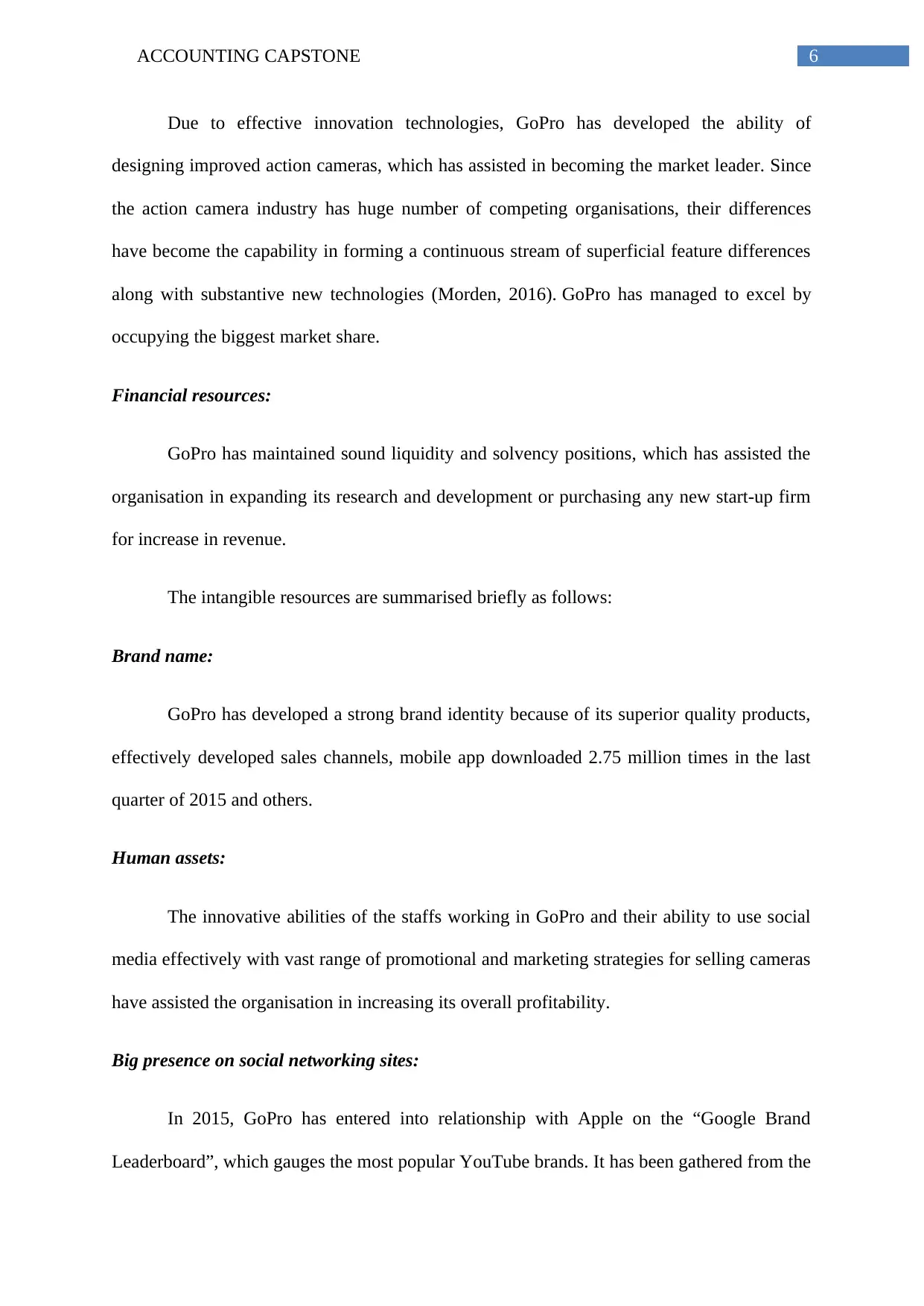
6ACCOUNTING CAPSTONE
Due to effective innovation technologies, GoPro has developed the ability of
designing improved action cameras, which has assisted in becoming the market leader. Since
the action camera industry has huge number of competing organisations, their differences
have become the capability in forming a continuous stream of superficial feature differences
along with substantive new technologies (Morden, 2016). GoPro has managed to excel by
occupying the biggest market share.
Financial resources:
GoPro has maintained sound liquidity and solvency positions, which has assisted the
organisation in expanding its research and development or purchasing any new start-up firm
for increase in revenue.
The intangible resources are summarised briefly as follows:
Brand name:
GoPro has developed a strong brand identity because of its superior quality products,
effectively developed sales channels, mobile app downloaded 2.75 million times in the last
quarter of 2015 and others.
Human assets:
The innovative abilities of the staffs working in GoPro and their ability to use social
media effectively with vast range of promotional and marketing strategies for selling cameras
have assisted the organisation in increasing its overall profitability.
Big presence on social networking sites:
In 2015, GoPro has entered into relationship with Apple on the “Google Brand
Leaderboard”, which gauges the most popular YouTube brands. It has been gathered from the
Due to effective innovation technologies, GoPro has developed the ability of
designing improved action cameras, which has assisted in becoming the market leader. Since
the action camera industry has huge number of competing organisations, their differences
have become the capability in forming a continuous stream of superficial feature differences
along with substantive new technologies (Morden, 2016). GoPro has managed to excel by
occupying the biggest market share.
Financial resources:
GoPro has maintained sound liquidity and solvency positions, which has assisted the
organisation in expanding its research and development or purchasing any new start-up firm
for increase in revenue.
The intangible resources are summarised briefly as follows:
Brand name:
GoPro has developed a strong brand identity because of its superior quality products,
effectively developed sales channels, mobile app downloaded 2.75 million times in the last
quarter of 2015 and others.
Human assets:
The innovative abilities of the staffs working in GoPro and their ability to use social
media effectively with vast range of promotional and marketing strategies for selling cameras
have assisted the organisation in increasing its overall profitability.
Big presence on social networking sites:
In 2015, GoPro has entered into relationship with Apple on the “Google Brand
Leaderboard”, which gauges the most popular YouTube brands. It has been gathered from the
Paraphrase This Document
Need a fresh take? Get an instant paraphrase of this document with our AI Paraphraser
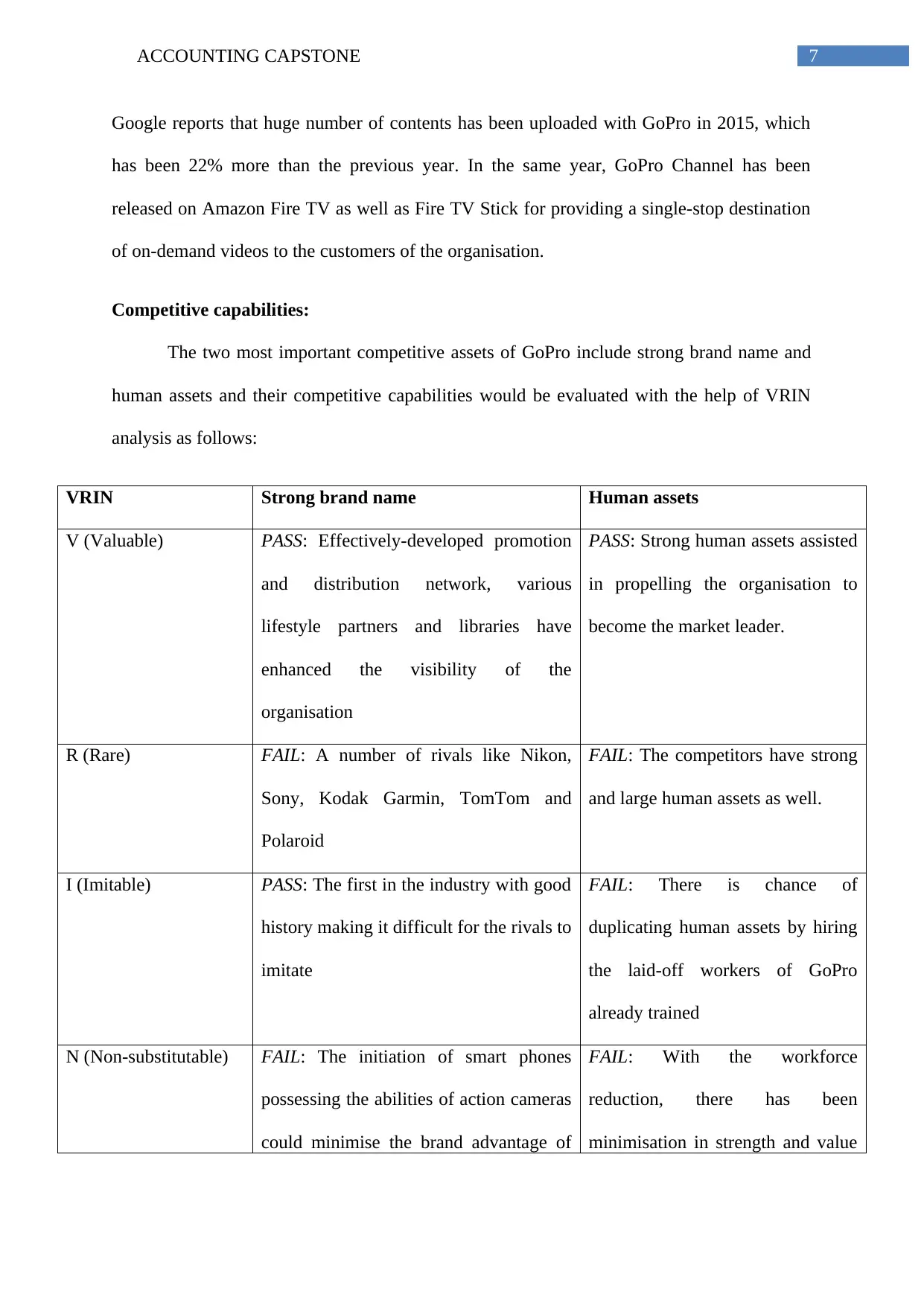
7ACCOUNTING CAPSTONE
Google reports that huge number of contents has been uploaded with GoPro in 2015, which
has been 22% more than the previous year. In the same year, GoPro Channel has been
released on Amazon Fire TV as well as Fire TV Stick for providing a single-stop destination
of on-demand videos to the customers of the organisation.
Competitive capabilities:
The two most important competitive assets of GoPro include strong brand name and
human assets and their competitive capabilities would be evaluated with the help of VRIN
analysis as follows:
VRIN Strong brand name Human assets
V (Valuable) PASS: Effectively-developed promotion
and distribution network, various
lifestyle partners and libraries have
enhanced the visibility of the
organisation
PASS: Strong human assets assisted
in propelling the organisation to
become the market leader.
R (Rare) FAIL: A number of rivals like Nikon,
Sony, Kodak Garmin, TomTom and
Polaroid
FAIL: The competitors have strong
and large human assets as well.
I (Imitable) PASS: The first in the industry with good
history making it difficult for the rivals to
imitate
FAIL: There is chance of
duplicating human assets by hiring
the laid-off workers of GoPro
already trained
N (Non-substitutable) FAIL: The initiation of smart phones
possessing the abilities of action cameras
could minimise the brand advantage of
FAIL: With the workforce
reduction, there has been
minimisation in strength and value
Google reports that huge number of contents has been uploaded with GoPro in 2015, which
has been 22% more than the previous year. In the same year, GoPro Channel has been
released on Amazon Fire TV as well as Fire TV Stick for providing a single-stop destination
of on-demand videos to the customers of the organisation.
Competitive capabilities:
The two most important competitive assets of GoPro include strong brand name and
human assets and their competitive capabilities would be evaluated with the help of VRIN
analysis as follows:
VRIN Strong brand name Human assets
V (Valuable) PASS: Effectively-developed promotion
and distribution network, various
lifestyle partners and libraries have
enhanced the visibility of the
organisation
PASS: Strong human assets assisted
in propelling the organisation to
become the market leader.
R (Rare) FAIL: A number of rivals like Nikon,
Sony, Kodak Garmin, TomTom and
Polaroid
FAIL: The competitors have strong
and large human assets as well.
I (Imitable) PASS: The first in the industry with good
history making it difficult for the rivals to
imitate
FAIL: There is chance of
duplicating human assets by hiring
the laid-off workers of GoPro
already trained
N (Non-substitutable) FAIL: The initiation of smart phones
possessing the abilities of action cameras
could minimise the brand advantage of
FAIL: With the workforce
reduction, there has been
minimisation in strength and value
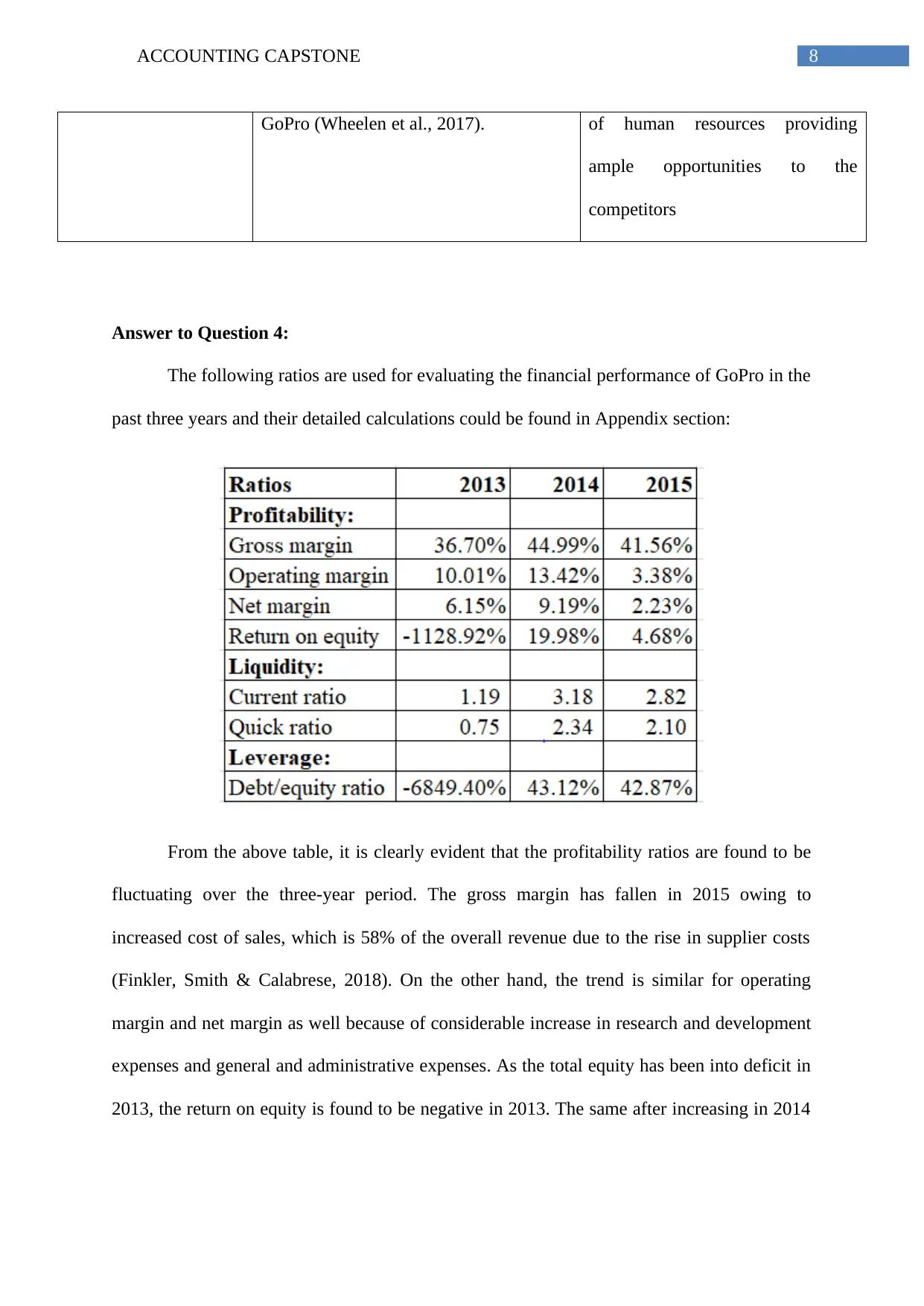
8ACCOUNTING CAPSTONE
GoPro (Wheelen et al., 2017). of human resources providing
ample opportunities to the
competitors
Answer to Question 4:
The following ratios are used for evaluating the financial performance of GoPro in the
past three years and their detailed calculations could be found in Appendix section:
From the above table, it is clearly evident that the profitability ratios are found to be
fluctuating over the three-year period. The gross margin has fallen in 2015 owing to
increased cost of sales, which is 58% of the overall revenue due to the rise in supplier costs
(Finkler, Smith & Calabrese, 2018). On the other hand, the trend is similar for operating
margin and net margin as well because of considerable increase in research and development
expenses and general and administrative expenses. As the total equity has been into deficit in
2013, the return on equity is found to be negative in 2013. The same after increasing in 2014
GoPro (Wheelen et al., 2017). of human resources providing
ample opportunities to the
competitors
Answer to Question 4:
The following ratios are used for evaluating the financial performance of GoPro in the
past three years and their detailed calculations could be found in Appendix section:
From the above table, it is clearly evident that the profitability ratios are found to be
fluctuating over the three-year period. The gross margin has fallen in 2015 owing to
increased cost of sales, which is 58% of the overall revenue due to the rise in supplier costs
(Finkler, Smith & Calabrese, 2018). On the other hand, the trend is similar for operating
margin and net margin as well because of considerable increase in research and development
expenses and general and administrative expenses. As the total equity has been into deficit in
2013, the return on equity is found to be negative in 2013. The same after increasing in 2014
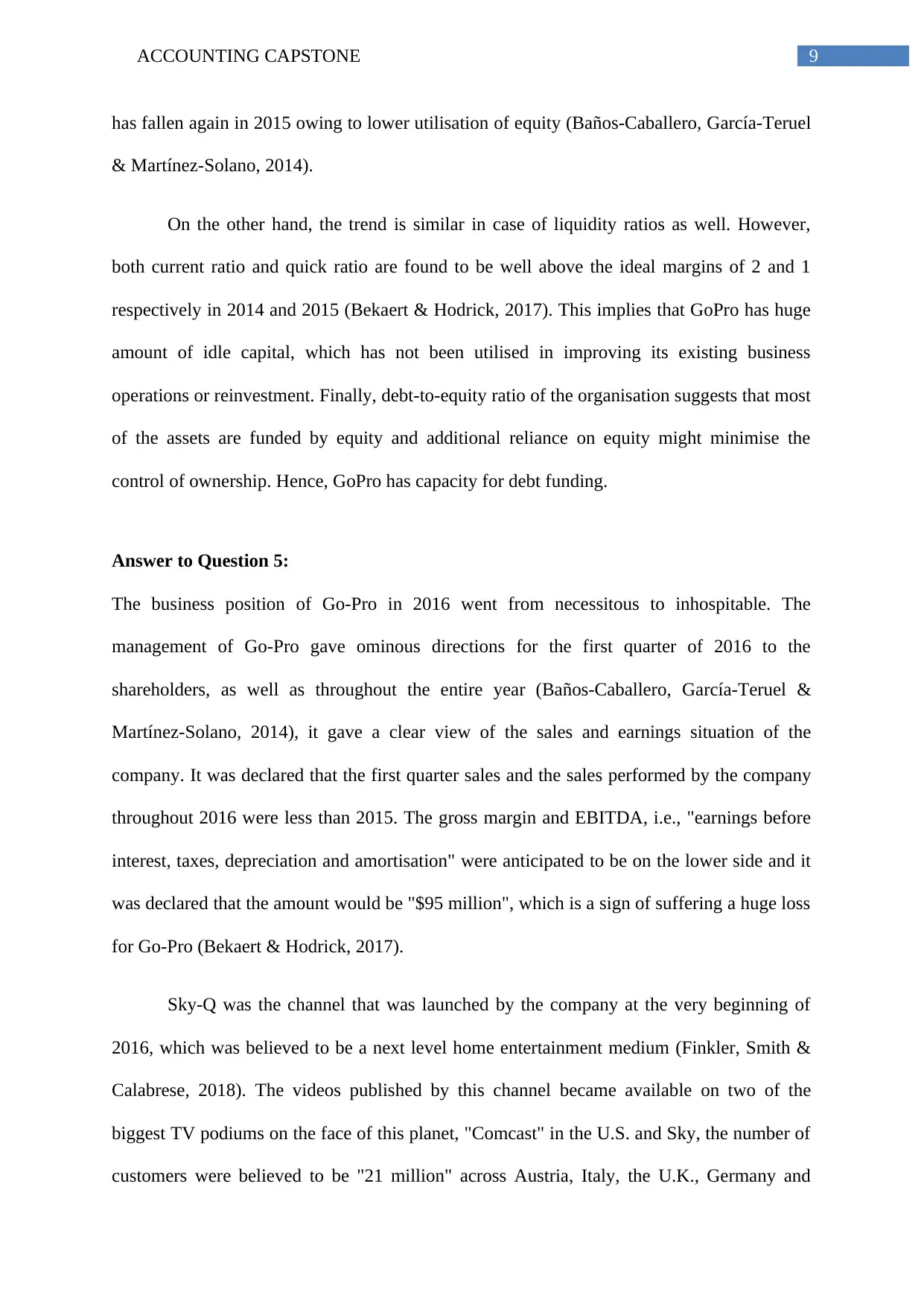
9ACCOUNTING CAPSTONE
has fallen again in 2015 owing to lower utilisation of equity (Baños-Caballero, García-Teruel
& Martínez-Solano, 2014).
On the other hand, the trend is similar in case of liquidity ratios as well. However,
both current ratio and quick ratio are found to be well above the ideal margins of 2 and 1
respectively in 2014 and 2015 (Bekaert & Hodrick, 2017). This implies that GoPro has huge
amount of idle capital, which has not been utilised in improving its existing business
operations or reinvestment. Finally, debt-to-equity ratio of the organisation suggests that most
of the assets are funded by equity and additional reliance on equity might minimise the
control of ownership. Hence, GoPro has capacity for debt funding.
Answer to Question 5:
The business position of Go-Pro in 2016 went from necessitous to inhospitable. The
management of Go-Pro gave ominous directions for the first quarter of 2016 to the
shareholders, as well as throughout the entire year (Baños-Caballero, García-Teruel &
Martínez-Solano, 2014), it gave a clear view of the sales and earnings situation of the
company. It was declared that the first quarter sales and the sales performed by the company
throughout 2016 were less than 2015. The gross margin and EBITDA, i.e., "earnings before
interest, taxes, depreciation and amortisation" were anticipated to be on the lower side and it
was declared that the amount would be "$95 million", which is a sign of suffering a huge loss
for Go-Pro (Bekaert & Hodrick, 2017).
Sky-Q was the channel that was launched by the company at the very beginning of
2016, which was believed to be a next level home entertainment medium (Finkler, Smith &
Calabrese, 2018). The videos published by this channel became available on two of the
biggest TV podiums on the face of this planet, "Comcast" in the U.S. and Sky, the number of
customers were believed to be "21 million" across Austria, Italy, the U.K., Germany and
has fallen again in 2015 owing to lower utilisation of equity (Baños-Caballero, García-Teruel
& Martínez-Solano, 2014).
On the other hand, the trend is similar in case of liquidity ratios as well. However,
both current ratio and quick ratio are found to be well above the ideal margins of 2 and 1
respectively in 2014 and 2015 (Bekaert & Hodrick, 2017). This implies that GoPro has huge
amount of idle capital, which has not been utilised in improving its existing business
operations or reinvestment. Finally, debt-to-equity ratio of the organisation suggests that most
of the assets are funded by equity and additional reliance on equity might minimise the
control of ownership. Hence, GoPro has capacity for debt funding.
Answer to Question 5:
The business position of Go-Pro in 2016 went from necessitous to inhospitable. The
management of Go-Pro gave ominous directions for the first quarter of 2016 to the
shareholders, as well as throughout the entire year (Baños-Caballero, García-Teruel &
Martínez-Solano, 2014), it gave a clear view of the sales and earnings situation of the
company. It was declared that the first quarter sales and the sales performed by the company
throughout 2016 were less than 2015. The gross margin and EBITDA, i.e., "earnings before
interest, taxes, depreciation and amortisation" were anticipated to be on the lower side and it
was declared that the amount would be "$95 million", which is a sign of suffering a huge loss
for Go-Pro (Bekaert & Hodrick, 2017).
Sky-Q was the channel that was launched by the company at the very beginning of
2016, which was believed to be a next level home entertainment medium (Finkler, Smith &
Calabrese, 2018). The videos published by this channel became available on two of the
biggest TV podiums on the face of this planet, "Comcast" in the U.S. and Sky, the number of
customers were believed to be "21 million" across Austria, Italy, the U.K., Germany and
Secure Best Marks with AI Grader
Need help grading? Try our AI Grader for instant feedback on your assignments.
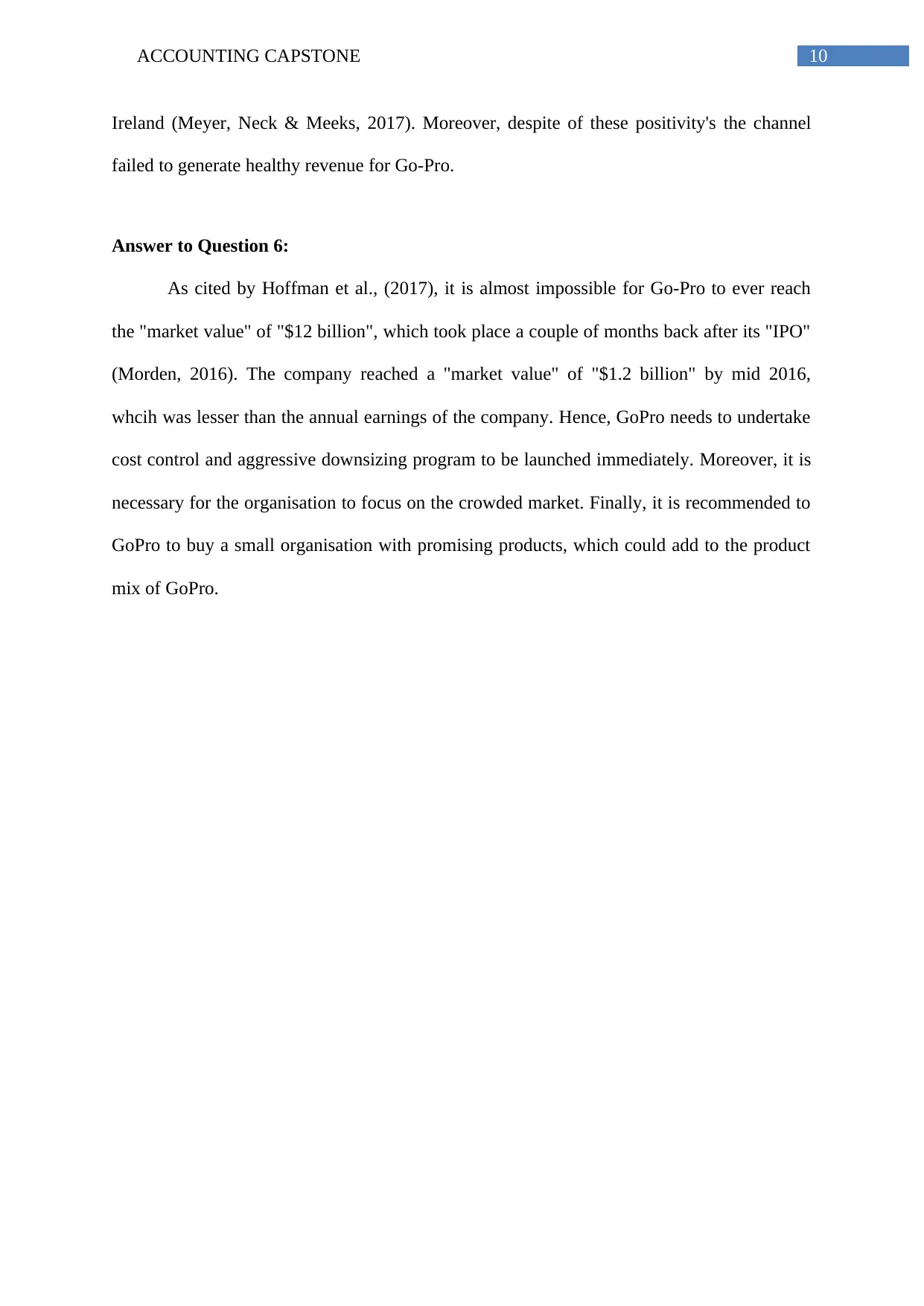
10ACCOUNTING CAPSTONE
Ireland (Meyer, Neck & Meeks, 2017). Moreover, despite of these positivity's the channel
failed to generate healthy revenue for Go-Pro.
Answer to Question 6:
As cited by Hoffman et al., (2017), it is almost impossible for Go-Pro to ever reach
the "market value" of "$12 billion", which took place a couple of months back after its "IPO"
(Morden, 2016). The company reached a "market value" of "$1.2 billion" by mid 2016,
whcih was lesser than the annual earnings of the company. Hence, GoPro needs to undertake
cost control and aggressive downsizing program to be launched immediately. Moreover, it is
necessary for the organisation to focus on the crowded market. Finally, it is recommended to
GoPro to buy a small organisation with promising products, which could add to the product
mix of GoPro.
Ireland (Meyer, Neck & Meeks, 2017). Moreover, despite of these positivity's the channel
failed to generate healthy revenue for Go-Pro.
Answer to Question 6:
As cited by Hoffman et al., (2017), it is almost impossible for Go-Pro to ever reach
the "market value" of "$12 billion", which took place a couple of months back after its "IPO"
(Morden, 2016). The company reached a "market value" of "$1.2 billion" by mid 2016,
whcih was lesser than the annual earnings of the company. Hence, GoPro needs to undertake
cost control and aggressive downsizing program to be launched immediately. Moreover, it is
necessary for the organisation to focus on the crowded market. Finally, it is recommended to
GoPro to buy a small organisation with promising products, which could add to the product
mix of GoPro.

11ACCOUNTING CAPSTONE
References:
Baños-Caballero, S., García-Teruel, P. J., & Martínez-Solano, P. (2014). Working capital
management, corporate performance, and financial constraints. Journal of Business
Research, 67(3), 332-338.
Bekaert, G., & Hodrick, R. (2017). International financial management. Cambridge
University Press.
David, F. R., & David, F. R. (2016). Strategic management: A competitive advantage
approach, concepts and cases. Pearson.
Dobni, C. B., Klassen, M., & Sands, D. (2016). Getting to clarity: new ways to think about
strategy. Journal of Business Strategy, 37(5), 12-21.
Finkler, S. A., Smith, D. L., & Calabrese, T. D. (2018). Financial management for public,
health, and not-for-profit organizations. CQ Press.
Gamble, J., & Thompson, A. A. (2014). Essentials of strategic management. Irwin Mcgraw-
Hill.
Gopro.com. (2019). GoPro | The world's most versatile action cameras. Retrieved 20 March
2019, from https://gopro.com/
Hill, C. W., Jones, G. R., & Schilling, M. A. (2014). Strategic management: Theory & cases:
An integrated approach. Cengage Learning.
Hubbard, G., Rice, J., & Galvin, P. (2014). Strategic management. Pearson Australia.
Lasserre, P. (2017). Global strategic management. Macmillan International Higher
Education.
References:
Baños-Caballero, S., García-Teruel, P. J., & Martínez-Solano, P. (2014). Working capital
management, corporate performance, and financial constraints. Journal of Business
Research, 67(3), 332-338.
Bekaert, G., & Hodrick, R. (2017). International financial management. Cambridge
University Press.
David, F. R., & David, F. R. (2016). Strategic management: A competitive advantage
approach, concepts and cases. Pearson.
Dobni, C. B., Klassen, M., & Sands, D. (2016). Getting to clarity: new ways to think about
strategy. Journal of Business Strategy, 37(5), 12-21.
Finkler, S. A., Smith, D. L., & Calabrese, T. D. (2018). Financial management for public,
health, and not-for-profit organizations. CQ Press.
Gamble, J., & Thompson, A. A. (2014). Essentials of strategic management. Irwin Mcgraw-
Hill.
Gopro.com. (2019). GoPro | The world's most versatile action cameras. Retrieved 20 March
2019, from https://gopro.com/
Hill, C. W., Jones, G. R., & Schilling, M. A. (2014). Strategic management: Theory & cases:
An integrated approach. Cengage Learning.
Hubbard, G., Rice, J., & Galvin, P. (2014). Strategic management. Pearson Australia.
Lasserre, P. (2017). Global strategic management. Macmillan International Higher
Education.

12ACCOUNTING CAPSTONE
Meyer, G. D., Neck, H. M., & Meeks, M. D. (2017). The entrepreneurship‐strategic
management interface. Strategic entrepreneurship: Creating a new mindset, 17-44.
Morden, T. (2016). Principles of strategic management. Routledge.
Patel, B. (2014). Fundamentals of financial management. Vikas Publishing House.
Stead, J. G., & Stead, W. E. (2014). Sustainable strategic management. Routledge.
Tjemkes, B., Vos, P., & Burgers, K. (2017). Strategic alliance management. Routledge.
Wheelen, T. L., Hunger, J. D., Hoffman, A. N., & Bamford, C. E. (2017). Strategic
management and business policy (p. 55). Boston: pearson.
Meyer, G. D., Neck, H. M., & Meeks, M. D. (2017). The entrepreneurship‐strategic
management interface. Strategic entrepreneurship: Creating a new mindset, 17-44.
Morden, T. (2016). Principles of strategic management. Routledge.
Patel, B. (2014). Fundamentals of financial management. Vikas Publishing House.
Stead, J. G., & Stead, W. E. (2014). Sustainable strategic management. Routledge.
Tjemkes, B., Vos, P., & Burgers, K. (2017). Strategic alliance management. Routledge.
Wheelen, T. L., Hunger, J. D., Hoffman, A. N., & Bamford, C. E. (2017). Strategic
management and business policy (p. 55). Boston: pearson.
Paraphrase This Document
Need a fresh take? Get an instant paraphrase of this document with our AI Paraphraser
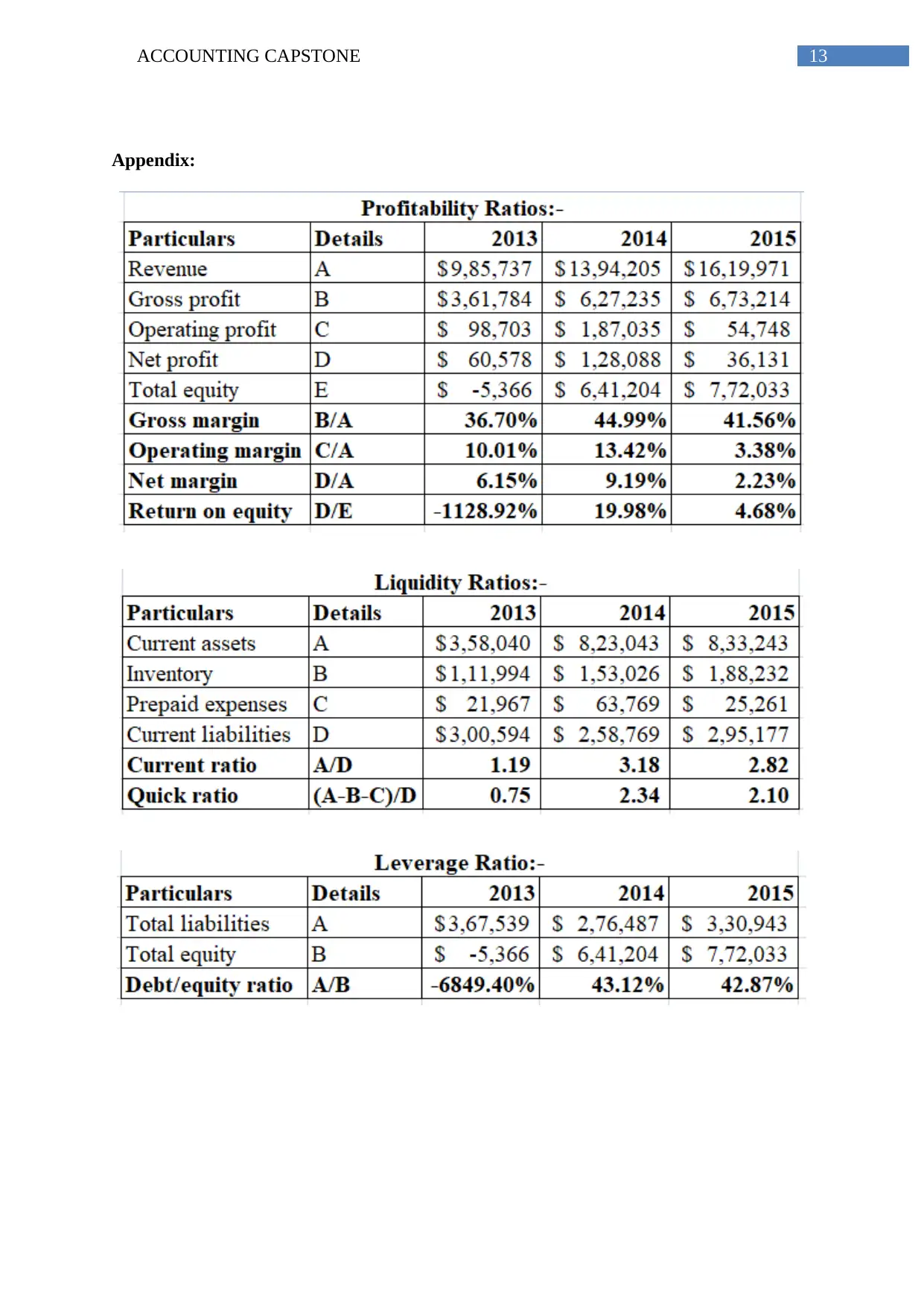
13ACCOUNTING CAPSTONE
Appendix:
Appendix:
1 out of 14
Your All-in-One AI-Powered Toolkit for Academic Success.
+13062052269
info@desklib.com
Available 24*7 on WhatsApp / Email
![[object Object]](/_next/static/media/star-bottom.7253800d.svg)
Unlock your academic potential
© 2024 | Zucol Services PVT LTD | All rights reserved.





